Food security in general and come over the animal protein
shortage is a real challenge in developing countries [1,2]. Minilivestock
farming, particularly caviaculture, seems to be an
alternative solution to face this gap of animal protein [3]. In
addition, this livestock, easy to breed, is an important source
of income for the revenues farmers in general and those in
Cameroon in particular. Despite the importance or advantages of
guinea pig, its productivity remains low. In fact, this traditional
breeding, practiced by women and children, suffers from a lack
of follow-up and technicality [4]. Most of their food comes from
kitchen waste and crop residues, which are qualitatively and
quantitatively deficient, and do not allow the animal to externalize
its genetic potential [5,6]. This is as true as food remain the main
factor of animal production [7]. Among nutrients used in guinea
pig diets, protein is the main limiting factor because they are fed
mostly on protein poor grasses. So, diet containing in quantity
and quality an optimal protein level can really improve the
growth and reproduction performances of guinea pigs [5,8,9].
Unfortunately, the high cost of conventional supplements and
their scarcity make them inaccessible to small farmers [4]. On the other hand, the presence of antinutritional factors in legumes
which are accessible and less expensive alternative source
protein, limits their use [2,10]. It became necessary to look for
other alternative resources of protein easily used by animals.
Spirulina contains a high amount of high quality protein (60-
70%), containing most essential amino acids, essential fatty acids,
vitamins A, B and E and available iron [11]. On the other hand,
spirulina has a high nutritional value compared to soy in terms of
crude protein, minerals, metabolizable energy and amino acids
[26]. It can be used as an alternative source of protein that can
improve production performance thanks to its optimum supply
of essential amino acids and the fact that it is easy to produce.
Thus the objective of this work is to improve animal nutrition by
diversifying proteins sources.
The study was conducted between April 2017 and January
2018 in the animal nutrition and production research unit of
the Faculty of Agronomy and Agricultural Sciences (FAAS) of the
University of Dschang. Dschang is a western highlands locality
of Cameroon with an altitude of 1450 m above sea. This locality
is located at the 15° of the eastern meridian at latitude 5 ° 26
‘27 “North and longitude 10 ° 26’ 29” East. It has an equatorial
climate of Cameroonian type modified by altitude. Dschang has
two seasons: a short dry season mid-November to mid-March
and a long rainy season that corresponds to the growing season
(mid-March to mid-November). The months of February and
March are generally the hottest, and the months of July and
August the coldest, rainfall varies between 1500 and 2000 mm
per year. The average annual temperature is around 20 °C, the
annual total insolation is 1800 hours and the average relative
humidity range between 40 and 90%. The original vegetation of
the region is a shrub savannah with some gallery forests. Apart
from commercial activities, the area is strongly agro-pastoral. Dschang is a part of the western highlands of Cameroon an
altitude of 1450 m above sea.
Animal Material and Housing
A total of 59 young weaning guinea pigs, 3 weeks old, were
used for the test. They were housed in fattening boxes according
to the ethics and rules of such animals. These boxes made of
plywood (1.25 mx 0.6 mx 0.8 m), were mounted on the floor. Each
was equipped with a lighting device, two wooden feeders, two
concrete drinkers and a small wire mesh cover, which prevented
the intrusion of mice or other possible predators. All animals
used in this trial were from mothers submitted to the same diet
during gestation and pre-weaning growth period.
Experimental Diets and Conducting the Trial
On the basis of the bibliographic data, four iso-caloric (2800
kcal) and iso-Nitrogenous (19% PB) experimental diet, R0, R1,
R2, R3 of different spirulina level (0, 2, 4 and 6% respectively)
were formulated. These diets were then allocated to batches
TS0, TS2, TS4 and TS6 to evaluate growth performance from
the 3rd to the 8th weeks. For this study, the grass (Trypsacum
laxum) was harvested (stem and leaves) from the forage plots
of the Dschang University farm, pre-dressed by soon dry for two hours before being fed to animals. Spirulina was purchased in the
surrounding markets of Lake Chad and transported to Dschang to
be dried, milled and incorporated at different levels to form the
experimental rations.
Other ingredients (corn, wheat bran, cottonseed cake,
soybean meal, palm kernel meal, fishmeal, fish meal, premix and
palm oil) came from the Dschang market, from the by-product
resellers. A sample of 100 g of each experimental diet and forage
was taken and transported in Animal Production and Nutrition
research unit (LAPRONAN) to be dried in an oven at 60 ° C. for
12 hours (up to constant weight) and then ground using 1-mm
mesh screen and kept in plastic bags for evaluation of their dry
matter (DM), organic matter (OM), crude protein (CP) content ),
and crude fiber (CF) content according to the AOAC [12] method.
Proportion of experimental diets and their nutritional value
are recorded in Table 1.
At weaning (3 weeks of age), young guinea pigs, from
mothers receiving respectively one of the above treatments were
sexed, identified and weighed. They were then assigned to boxes
corresponding to their mother’s diet. From the beginning of this
trial, the numbers of females and males were recorded. Each
morning between 8am and 9am, each young guinea pig received 40g of an experimental ration (R1, R2, R3, or R4) corresponding
to its batch (TS0, TS2, TS4 or TS6). Fodder (Trypsacum laxum)
was prefilled for 2 hours on the sun, weighed and served ad
libitum in such a way that each group receives the same quantity.
Vitamin C was distributed in a drinking water and served at will
to animals and renewed every day. Food leftover were weighed
each morning before new distributions of known quantity of food
to evaluate food intake. The monitoring of each young guinea pig
was done individually. Thus, each of them was weighed every
seven days up to 8 weeks of age and their weights recorded for
evaluating the post-weaning weight gain from the 3rd to the 8th
week as well as their weight gains (TWG and DWG) at the 8th
week. The cleaning of the boxes was done every two days to avoid
any accumulation of feces and urine. All the weighing process
was carried out using an electronic balance of capacity 7 kg and
precision 1g.
Post-weaning growth parameters were submitted to twofactor
analysis of variance according to spirulina level and
animal sex or type of birth. Those on the feed intake were
submitted to one-factor of analysis of variance (spirulina level).
When differences existed between treatments, the means were
separated by the Waller Duncan test at the 5% significance level
[13]. The separation of the means between the sexes (male and
female) on the one hand and between the types of birth (double
and single) on the other hand was done using Student’s t-test.
SPSS 20.0 software was used.
Effect of spirulina level on food intake in young postweaning guinea pigs
The intake of T. laxum, concentrate and nutrients was significantly (p˂ 0.05) influenced by the spirulina level of the
ration (Figure 1). In fact, T. laxum intake of TS2 and TS6 treatment
was comparable (p ˃0.05), but significantly (p˂ 0.05) higher than
that of TS0 and TS4 animals, which also remained comparable
with each other. The concentrate intake was significantly (p˂
0.05) higher in the animals of the treated groups (TS2, TS4 and
TS6) compared to those of the control group. Dry matter (DM),
organic matter (OM), crude fiber (CF), and crude protein (CP)
intake was significantly (p˂ 0.05) influenced by the level of
spirulina. In fact, the DM and OM intake significantly (p˂ 0.05)
higher was observed with animals from TS2 and TS6 batches.
However, the intake of the two other treatments remained
comparable (p ˃ 0.05). The highest crude fiber (CF) intake was
observed in animals of batch TS2, followed by those of group TS6.
That of animals from TS0 and TS4 groups was comparable (p ˃
0.05) between them. The same trend has been observed for crude
protein intake.
-
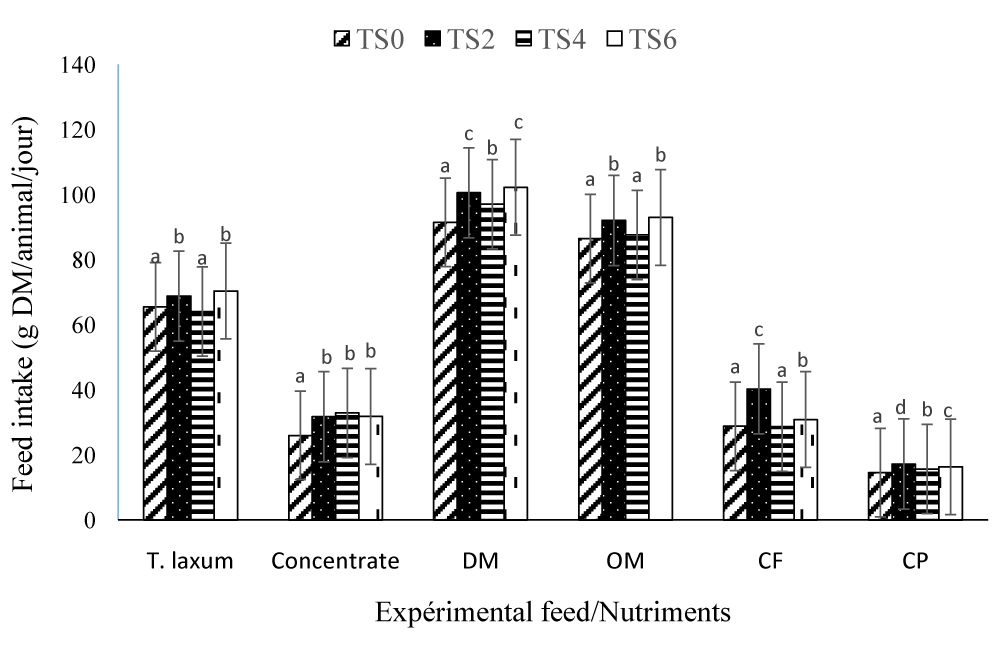 Figure 1: T. laxum, compound feed and nutrients intake depending on the spirulina level in the diet
Post-weaning growth performances.
Figure 1: T. laxum, compound feed and nutrients intake depending on the spirulina level in the diet
Post-weaning growth performances.
a, b, c, d: means with the same letters on the same treatment are not significantly different at the 5% level. DM: Dry Matter; OM: Organic Matter; CF:
Crude Fiber; CP: Crude Protein.
View Figure
The weight of young weaning guinea pigs at eight weeks
independently on sex has increased steadily in different groups
(Figure 2). From the 3rd to the 5th week, the average weight in
TS0, TS2 and TS6 groups of animals was higher than that of the
TS4 animals. From the 7th to 8th week, the average weights of
animal from different batches (TS0, TS2, TS4 and TS6) remained
comparable to each other.
-
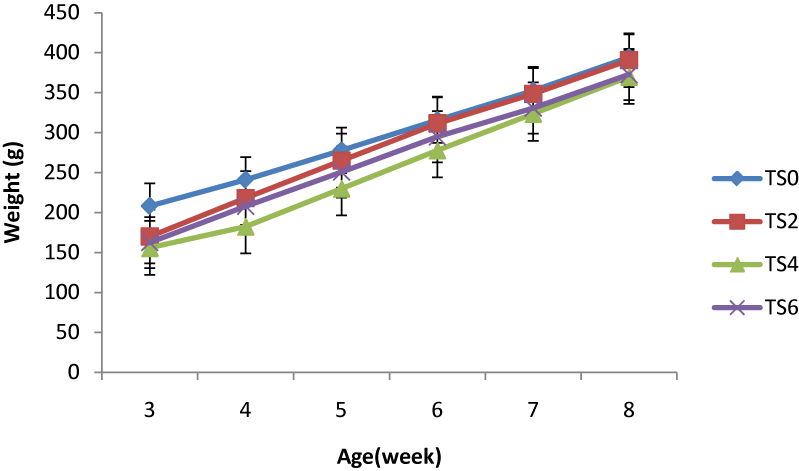 Figure 3: Post-weaning weight evolution of young male guinea pigs according to different diets. The weight of young males increased steadily from
weaning to week 8 (figure 3). During the 3rd, 4th, 5th and 6th week of age, young males in the control group (TS0) showed higher weights than
animals in the other lots. From the 7th to the 8th week, the weight of the animals of the control group (TS0) and those of TS2, TS4 and TS6 batches
were identical to each other. View Figure
Figure 3: Post-weaning weight evolution of young male guinea pigs according to different diets. The weight of young males increased steadily from
weaning to week 8 (figure 3). During the 3rd, 4th, 5th and 6th week of age, young males in the control group (TS0) showed higher weights than
animals in the other lots. From the 7th to the 8th week, the weight of the animals of the control group (TS0) and those of TS2, TS4 and TS6 batches
were identical to each other. View Figure
Effect of spirulina level on weight at 8 weeks and weight gains of post-weaning guinea pigs
The weight at 8 weeks of young males decreased with the
spirulina level of the diet table 2. In fact, the highest weight of the
young males (394.20 g) was observed in the animals of the batch
TS0 while the lowest (369. 67 g) was observed in the animals of the lot TS4. However no significant difference (p ˃ 0.05) was
observed between treatments. The weight of young females postweaned
was significantly (p ˂ 0.05) influenced by the spirulina
level of the diet. The highest weight (416.56 g) of young females
was observed in TS6 animals group while the lowest (397.88
g) was observed in TS4 animals group. However, no significant
difference (p ˃ 0.05) was observed between animals of the
control group and those of group TS4 on the one hand, and those
of lots TS2 and TS6 on the other hand. By the way, regardless
of sex, the average weight of young guinea pigs has evoluate to
sawtooth way with the spirulina level in the ration. Indeed, the
highest average weight (407.03 g) of the young guinea pigs was
obtained in the animals of the TS2 lot and the lowest (396.64g) in the control group. However, no significant difference (p ˂ 0.05)
was observed between treatments. Total weight gain (TWG) and
daily weight gain (DWG) were significantly (p ˂ 0.05) influenced
by the spirulina level of the ration. In fact, the TWG of the animals
of the treated lots (TS2, TS4 and TS6) remained significantly (p
˂ 0.05) higher than those of the control (TS0). These TWG and
DWG at the 8th week were comparable (p ˃ 0.05) in the animals of
the treated groups irrespective of the treatment and regardless
of the sex. The TWG and the DWG of TS0 group were significantly
(p ˂ 0.05) lower than that of the other groups.
Figures 5 and 6 and shows that at weaning, males and females
had comparable TWG and DWG regardless of treatment. A
significant difference (p < 0.05) was observed between males and females in TS0; females being heavier than males. However, no
significant differences (p > 0.05) were observed between males
and females of the other groups.
-
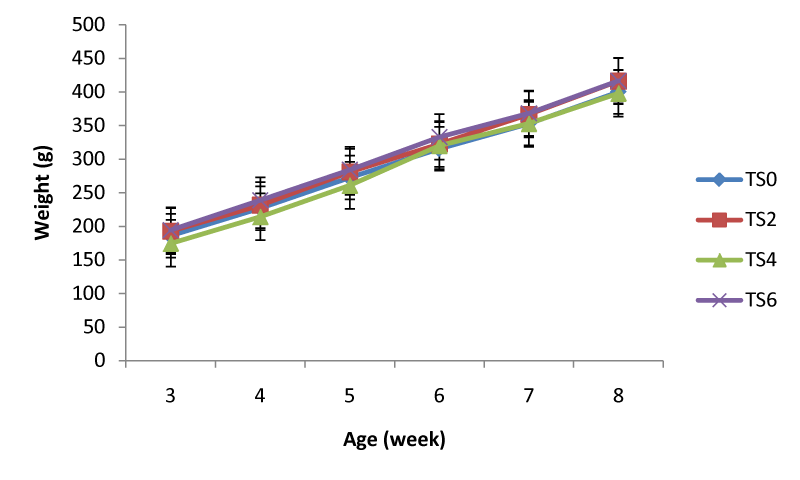 Figure 4: Post-weaning weight evolution of young females according to different treatment. The weight of young weaning females guinea pigs
increased steadily from weaning to the 8th week of age regardless of the treatment (figure 4). From the 3rd to the 6th week, all the young females
had similar weights regardless of the treatment. From the 6th to the 8th week, the young females of the TS0, TS2 and TS6 groups were higher than
those of the TS4 group. View Figure
Figure 4: Post-weaning weight evolution of young females according to different treatment. The weight of young weaning females guinea pigs
increased steadily from weaning to the 8th week of age regardless of the treatment (figure 4). From the 3rd to the 6th week, all the young females
had similar weights regardless of the treatment. From the 6th to the 8th week, the young females of the TS0, TS2 and TS6 groups were higher than
those of the TS4 group. View Figure
-
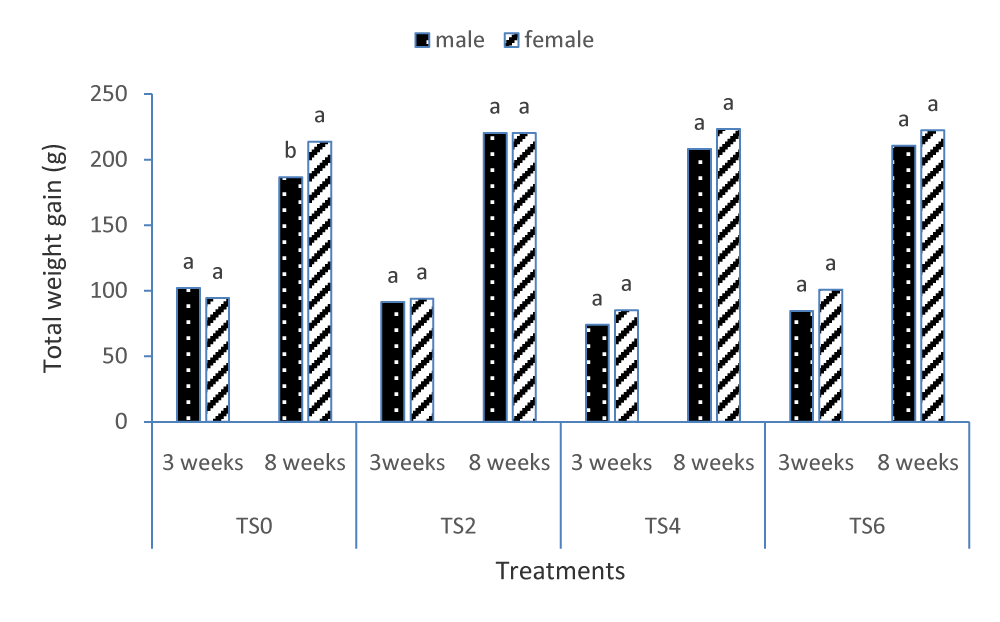 Figure 5: Total weight gain compared between males and females at week 3 (weaning) and week 8 (post-weaning), based on dietary rations.
Figure 5: Total weight gain compared between males and females at week 3 (weaning) and week 8 (post-weaning), based on dietary rations.
a,, b, c: Mean bearing the same letters on the same line are not significantly different at the 5% level; SEM: standard error on meam; p: Probability;
TS0, TS2, TS4, TS6: Trypsacum laxum+ Compound feed containing 0, 2, 4 and 6% of spirulina.
View Figure
-
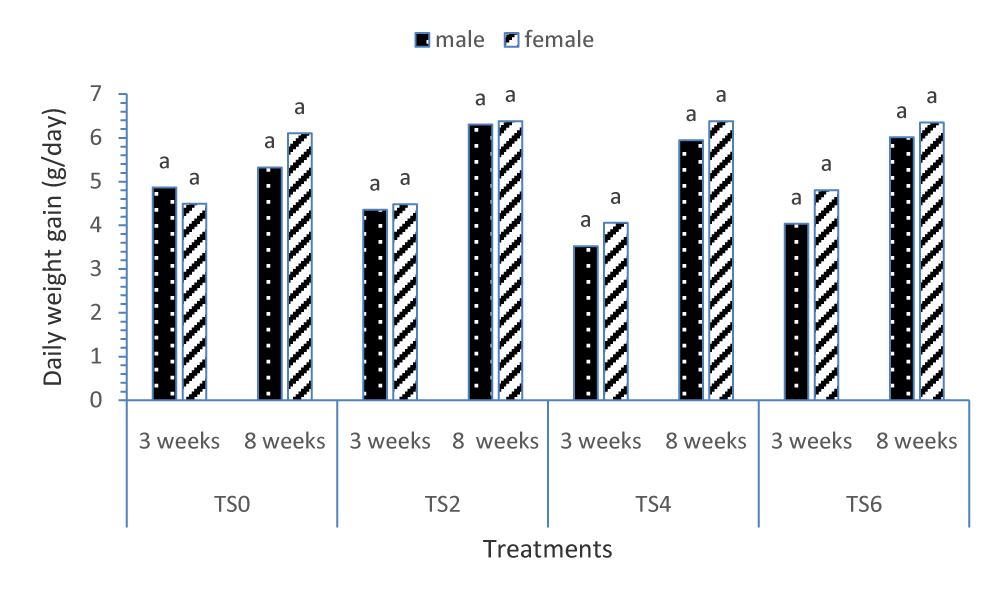 Figure 6: Compared daily weight gain (DWG) between males and female at 3rd and 8th week years old, based on dietary rations.
Figure 6: Compared daily weight gain (DWG) between males and female at 3rd and 8th week years old, based on dietary rations.
a,, b, c: Mean bearing the same letters on the same line are not significantly different at the 5% level; SEM: standard error on meam; p: Probability;
TS0, TS2, TS4, TS6: Trypsacum laxum+ Compound feed containing 0, 2, 4 and 6% of spirulina.
View Figure
Effect of spirulina level on weaning weight at 8 weeks and weight gain of post-weaning pigs by type of birth
Table 3 shows the effect of spirulina level on weight and the
weight gains of young post-weaned guinea pigs at 8 weeks at
different spirulina level.
This table shows that the inclusion of spirulina significantly
influenced (p < 0.05) the weight of young guinea pigs from single
births to 8 weeks. It also significantly influenced (p < 0.05) total
weight gain and daily weight gain of these animals regardless of
the type of birth. In fact, the highest (458.83g) average weight of
animals born from single birth was observed in batch TS6 while
the lowest (368.17g) was observed in batch TS4. The statistical
analysis showed that the weight of the subjects of lots TS0, TS2
and TS6 was comparable (p ˃ 0.05), but significantly higher than
that of lot TS4. The same trend has been observed in animals
born from double births. However, the animals of lots TS0, TS2
and TS4 had comparable (p ˃ 0.05) weights, but significantly
(p ˂ 0.05) lower than that of lot TS6. It was the same for TWG
and DWG regardless of the type of birth. Indeed, the highest GT
and GMQ (271.17g and 270.10g) and (7.75g / d and 7.72g / d)
respectively for single and double births, were observed in the
lot TS6. The animals in lots TS0, TS2 and TS4 had comparable GT
and GMQ (p ˂ 0.05), but significantly (p ˂ 0.05) lower than those
in lot TS6.
Effect of spirulina level on food intake of young postweaned guinea pigs
Compared to the control diet, the intake of T. laxum was
significantly higher with the supplemented diet. This forage is very popular with guinea pigs [14]. In addition, the protein intake
of spirulina would have increased the palatability of guinea pigs.
In fact, several works illustrate this observation [10,15,16]. The
best ingestion of this grass obtained with the ration containing
6% spirulina is explained by the fact that protein supplements
promote a sufficient proliferation of intestinal microorganisms
involved in digestion in guinea pigs. This would favor the increase
of food fermentation and digestive transit which would thus declutter
the caecum with the consequent increase in food intake [15,17].
In guinea-pigs fed T. laxum, the high intake of the compound
feed containing spirulina compared to the control diet, is
explained by the fact that supplementation with spirulina would
have improved acceptability, palatability and digestibility as
shown by Marie-Christine [18] in poultry, pork and horses even if
their digestive system is different of that of guinea pigs. The high
ingestion of the compound feed of TS4 batch animals is explained
by the substitution phenomenon [19]. In fact, these authors
reported that, when feed supplementing forage consumed at will
is distributed separately, part of the supplement is substituted for
the staple and occupies part of the digestive tract of the animal.
The level of intake of total dry matter (DM), organic matter
(OM), crude fiber (CF), and crude protein (CP) from spirulinacontaining
diets, was higher in guinea pigs compared to that of
control, corroborates with the observations of Fotna [20] who
showed that the incorporation of 10% spirulina into the stubble
improves significantly the ingestion of DM and OM in african
dwarf goat. The greatest value of ingestion (102.28 gMS / animal
/ day) of the recorded dry matter is greater than that obtained
by Kouakou et al. [15] (74.30 gMS / animal/day), Zougou [21]
(59.97 gMS /animal/day), Noumbissi et al. [8] (58.12 gMS /
animal / day), Mweugang et al. [22], (43.72 gMS /animal / day)
and Miégoué et al. [10] (24.6 gMS /animal / day). However, it is less than 115.80 gMS /animal/ day obtained by Egena et al.
[23]. These differences in intake would probably be related to
the experimental foods used in each of these studies. Indeed,
Kouakou et al. [15], showed that the ingestion of forage depends
on the type of supplement associated with it. They could also
be explained by the absence of antinutritional factors in the
spirulina and its chemical composition, including the quality of
its protein, its polyunsaturated fatty acids and its pleasant taste
that would stimulate acceptability and appetite in these animals
[24]. Indeed, Razafindrajaona et al. [25], reported that spirulina
can be used as a feed enhancer to increase livestock production.
It would also be related to the Energy / Protein ratio of the ration.
Indeed, Egena et al. [23] showed that herbivorous mammals
regulate their intake as a function of the digestible energy (ED)
content of the diet. Indeed, an increase in the fiber content of the
diet is equivalent to a decrease in digestible energy.
Effect of spirulina level on weight gain in young postweaned guinea pigs during the fattening test
From the 3rd to the 8th week, the weight of the young guinea
pigs has significantly increased with the level of spirulina. During
this period, the weight of animals fed 6% spirulina increased
from 183.25g to 402.59g. Those animals subjected to TS4, TS2
and TS0 increased from 169.65 to 397.10; from 184.97 to 407.02
and from 189.39 to 396.64 g respectively, a total weight growth
of 219.34 g; 228,1g; 222.05g and 227.45g. At 8 weeks the highest
average weight (407.02 g) was recorded in animals of batch TS2.
This weight was higher than those obtained by many authors
[2,9]. These differences could be explained by the chemical
composition of spirulina, in particular its high protein value,
which provides an optimal supply of essential amino acids [26]
which would stimulate growth, but could also be explained by
the rapid growth of young guinea pigs. The high value of weight
at 8 weeks of age is also explained by the fact that spirulina 2%
would have ensured a good energy / protein balance and even mineral that would stimulate growth. Indeed, Egena et al. [27],
showed that growth from birth to weaning, then weaning until
the 6th week after weaning; young guinea pigs double and even
more at the 8th week of age. Females were heavier than males.
This is contrary to the observations made by Zougou et al. [3].
who reported that males grow faster than females from birth to
adulthood. This observation, however, corroborates that made by
Miegoué et al. [9] and Pamo et al. [28], who showed that females
grow faster than males and that made by.
At the 8th week of age, the inclusion of 2% spirulina in the
young guinea pig diet resulted in the highest weights. The
significant increase in mean weight with spirulina level recorded
in this study is consistent with the observation made by
Razafindrajaona et al. [25], in rats treated with aqueous extracts
of spirulina at doses of 2 and 8 mg / kg body weight. It would
be related to the chemical composition of rations, the valuation
of spirulina food proteins by these young guinea pigs. Thus,
proteins is a growth factors and, when it quality can meet the
need of some essential amino acids of the animal; it can be very
benefic on growth performances and other related parameters.
This observation also corroborates that of Pirette and Meineri
[29] and Mamoud et al. [24], who have shown that the inclusion
of spirulina in the diet of rabbits stimulates their weight growth.
Indeed, Alvarenga et al. [13], and Mamoud et al. [24], have shown
that Spirulina contains 60 to 70% protein with optimal intake
of essential amino acids and minerals. Proteins are the most
important macromolecules for living organism. Thus, they play a
vital role in architecture, cell physiology and cellular metabolism.
However, the low weight value observed in young animals of
batch TS4 can be explain by the balance between nutrients. Thus
without equilibrium between nutrients, animals performances
can be disturb even when the level of some essentials nutrients
are higher. At 8 weeks of age, the significantly higher TWG were
obtained in treated groups (TS2, TS4, TS6). It was the same for
DWG. The DWG values of this study (6.34g / day) (6.80g / day) are higher than those obtained by Zougou et al. [3] (2.02, 1.78,
0.9 and 0.6g / day) when guinea pigs received 14% CP, 16%
CP and 18% CP in their diet. The highest DWG value (6.80g /
day) in this study is also greater than that obtained by Miégoué
et al. [9] (3,56g/day) when guinea pigs fed 20g of Calliandra
calothyrsus as supplement. This could due to the fact that, C.
calothyrsus as some others legumes contains antinutritional
factors such as tannins and mimosine that would have reduced
the use of dietary protein by herbivorous monogastrics. In the
other hand, the quality of protein contain in the spirulina could
have improved the metabolism of the animal and favored the growth rate. Indeed, Quigley and Poppi [30] have shown that
20% of dietary spirulina bypasses the protein degradation in
the rumen and makes it available for direct absorption into the
abomasum. The inclusion of spirulina in the ration of these postweaning
animals has resulted in a significant increase in average
weights, total weight gain (TWG) and daily weight gain (DWG).
Animals fed 6% spirulina from single births had higher TWG and
DWG than those from double births. This result corroborates that
obtained by Zougou et al. [3], Miégoué et al. [16], and could be
explained by the fact that animals from low litters are heavier at
birth than those born from multiple births, and that high litter sizes increase competition for resources food. By the same way,
animals of twin’s birth value better the diet containing 6% of
spirulina than other diet. This shown that from the twins birth,
animals require more protein especially higher quality protein.
Thus, 6% of spirulina have met the need of animals and improved
their growth performances.
The effect of graded level of spirulina level on post-weaning
growth performance of guinea pig (Cavia porcellus) was
evaluated. From this study, it appears that the levels of spirulina
in the diet have:
• Improved intake of T. laxum, the compound feed, the dry
matter (DM), the organic matter (OM), the crude fiber
(CF) and the crude protein (CP) intake.
• Not affect the average weight of guinea pigs regardless of sex.
• Improved total weight gain (TWG) and daily weight gain (DWG) of young guinea pigs.
• Improved the average weights, TWG and DWG of the guinea pigs according to the type of birth.
It appears that 2% spirulina can really affect growth
performances of guinea pig in the growth stage but, for twin’s
birth 6% is suitable. Spirulina can then be used for post-weaned
growth of young guinea pigs in West Cameroon.

 Table 1:Composition of formulated concentrate feeds with grades levels of spirulina.
Table 1:Composition of formulated concentrate feeds with grades levels of spirulina.  Figure 1: T. laxum, compound feed and nutrients intake depending on the spirulina level in the diet
Post-weaning growth performances.
Figure 1: T. laxum, compound feed and nutrients intake depending on the spirulina level in the diet
Post-weaning growth performances.
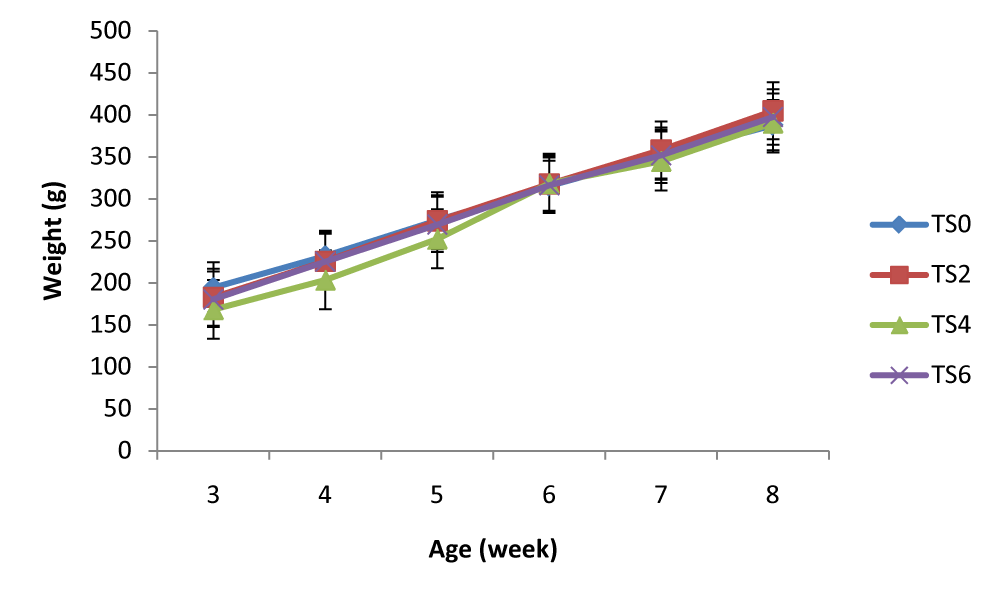 Figure 2: Post-weaning weight evolution of young guinea pigs according to different treatment.
Figure 2: Post-weaning weight evolution of young guinea pigs according to different treatment.  Figure 3: Post-weaning weight evolution of young male guinea pigs according to different diets. The weight of young males increased steadily from
weaning to week 8 (figure 3). During the 3rd, 4th, 5th and 6th week of age, young males in the control group (TS0) showed higher weights than
animals in the other lots. From the 7th to the 8th week, the weight of the animals of the control group (TS0) and those of TS2, TS4 and TS6 batches
were identical to each other.
Figure 3: Post-weaning weight evolution of young male guinea pigs according to different diets. The weight of young males increased steadily from
weaning to week 8 (figure 3). During the 3rd, 4th, 5th and 6th week of age, young males in the control group (TS0) showed higher weights than
animals in the other lots. From the 7th to the 8th week, the weight of the animals of the control group (TS0) and those of TS2, TS4 and TS6 batches
were identical to each other.  Figure 4: Post-weaning weight evolution of young females according to different treatment. The weight of young weaning females guinea pigs
increased steadily from weaning to the 8th week of age regardless of the treatment (figure 4). From the 3rd to the 6th week, all the young females
had similar weights regardless of the treatment. From the 6th to the 8th week, the young females of the TS0, TS2 and TS6 groups were higher than
those of the TS4 group.
Figure 4: Post-weaning weight evolution of young females according to different treatment. The weight of young weaning females guinea pigs
increased steadily from weaning to the 8th week of age regardless of the treatment (figure 4). From the 3rd to the 6th week, all the young females
had similar weights regardless of the treatment. From the 6th to the 8th week, the young females of the TS0, TS2 and TS6 groups were higher than
those of the TS4 group.  Figure 5: Total weight gain compared between males and females at week 3 (weaning) and week 8 (post-weaning), based on dietary rations.
Figure 5: Total weight gain compared between males and females at week 3 (weaning) and week 8 (post-weaning), based on dietary rations.
 Figure 6: Compared daily weight gain (DWG) between males and female at 3rd and 8th week years old, based on dietary rations.
Figure 6: Compared daily weight gain (DWG) between males and female at 3rd and 8th week years old, based on dietary rations.





























